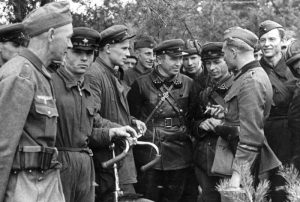The Guarini Institute for Public Affairs: 65th Anniversary of the End of WWII Remembered
The Guarini Institute for Public Affairs hosted two events commemorating the end of World War II. The first was an April 12 screening of the Andrzej Wajda film, “Katyn”. The film depicts the massacre Polish officers, intellectuals and ordinary citizens that took place during the initial Red Army occupation of half of Poland. The following week, Professor Portelli of La Sapienza led a guided tour of the Museo Storico della Liberazione which is in the partially restored prison where Nazi Germany housed its political prisoners during the occupation of Rome.
The screening of Katyn had been planned months in advance but came much more topical after the April 10 tragedy that took place in Smolensk, Russia. The Polish Ambassador to Rome had originally planned to participate but was forced to cancel in light of the weekend’s events.
After a moment of silence for the victims of the air crash that claimed the lives of Polish President Lech Kaczinksi, his wife and 94 others, Professor Eric Terzuolo introduced the film with background information on the actual Katyn Massacre and its memory in Poland, the Soviet Union and Russia. The Katyn Massacre took place during the 1939 occupation of Poland under the Molotov-Ribbentrop Pact, which divided Poland into German and Soviet sectors. The Soviet Occupation was interrupted by the German invasion of the Soviet Union in 1941 but was restored two years later.
As in other areas under Soviet occupation, the Red Army and the Soviet secret police (NKVD) initiated a rule of terror targeting members of the officer and politician class and also the ordinary citizens for imprisonment, relocation or execution. The Red Army, and Joseph Stalin in particular, held an animus for Poland, which had challenged the fledgling Russian communist state after the Bolshevik takeover. In order to nip in the bud any resistance that might arise in the occupied areas, the NKVD chief, Beria, proposed that the entire officer class of Poland be eliminated. Stalin and the Politburo approved the plan and tens of thousands of Polish officers and enlisted men were taken as POW’s and transported to the Katyn Forest. The officers were separated from the enlisted men and then shot and buried.
Not until the eve of its dissolution did the Soviet Union admit to any role in the Katyn Massacre. In some cases, families waited for years before finding out about the fate of their loved ones. During its reoccupation of Poland in 1943, Red Army propaganda blamed the massacre on the Germans. In 1992, Boris Yeltsin, the first President of the Russian Federation, opened the Soviet Archives for the first time. Scholars were able to read Beria’s correspondence with the Politburo and with Stalin himself over the planning and execution of the massacre.

A picture from World War II.
The film itself follows the story of one Polish officer, Andrzej, who is executed in Katyn. The director interwove Andrzej’s story with those of his relatives: his wife and child who did not find out about his fate for certain until after the war, his father who died in a Soviet camp and his officer comrades. The film is very graphic in its depiction of the violence carried out against the Polish people and also shows how little civilians knew about the Soviet Rule of Terror in the occupied areas during World War II. After its 2007 release, Katyn won 7 awards in Poland and was nominated for an Academy Award under Best Foreign Film.
On April 23, Professor Alessandro Portelli, who teaches American literature at La Sapienza and cultivates historical studies on the Roman Resistance, gave a guided tour of the Museo Storico della Liberazione at the Via Tasso, the former German Consulate until 1943. The building housed the prison where the Nazis held its political prisoners during its occupation of Rome in 1943-44. JCU faculty and students attended the tour, which included visits to the actual cells were prisoners were held to rooms showing leaflets, newspapers and posters from the Italian Resistance, the Allies, the Nazis and the Italian Fascist regime, as well as correspondence between the prisoners and their loved ones.
Hundreds of political prisoners (including partisans, officers and ordinary civilians) were arrested and many were executed. In many cases, Via Tasso served as a transit point for prisoners being deported or shot.. Professor Portelli paid special attention the cells which had been left more or less as they were during the war. The graffiti from the prisoners were still on the walls and the windows were still bricked up (to prevent communication with the outside, according to the inscription.)
The memory of the prison was also important to Professor Portelli. The resistance to the German Occupation of the city spanned all walks of life. Enlisted men were held across the hallway from famous prisoners like Giuseppe Cordero Lanza di Montezemolo, a victim of the Ardeatine Caves. Several exhibits grapple with the question of the changing memory of the Occupation. The curators use newspaper clippings and other contemporary sources and contrast them with how the events are now commemorated and remembered.
In another room, Professor Portelli pointed out a case holding jack rocks, two nails welded together to form four sharp points. During mining strikes in West Virginia, he had seen the same devices used to disable company vehicles. In Rome, they were part of the Resistance and were a constant drain on German resources during the Occupation.
Professor Portelli concluded the tour in the Jewish section of the museum where the Jewish prisoners are commemorated. The entrance hall of the annex is lined with the arrest records of the victims of the Ardeatine Caves, many of whom the forms indicate were shot on the same day of their arrest. The Jewish history of the occupation, noted Professor Portelli, is particularly fraught because of the historically non anti-Semitic Fascist Party.
After the tour was completed, the participants signed the guestbook of the museum and thanked Professor Portelli for his insight on the exhibits and on the history of the Resistance in Rome.





